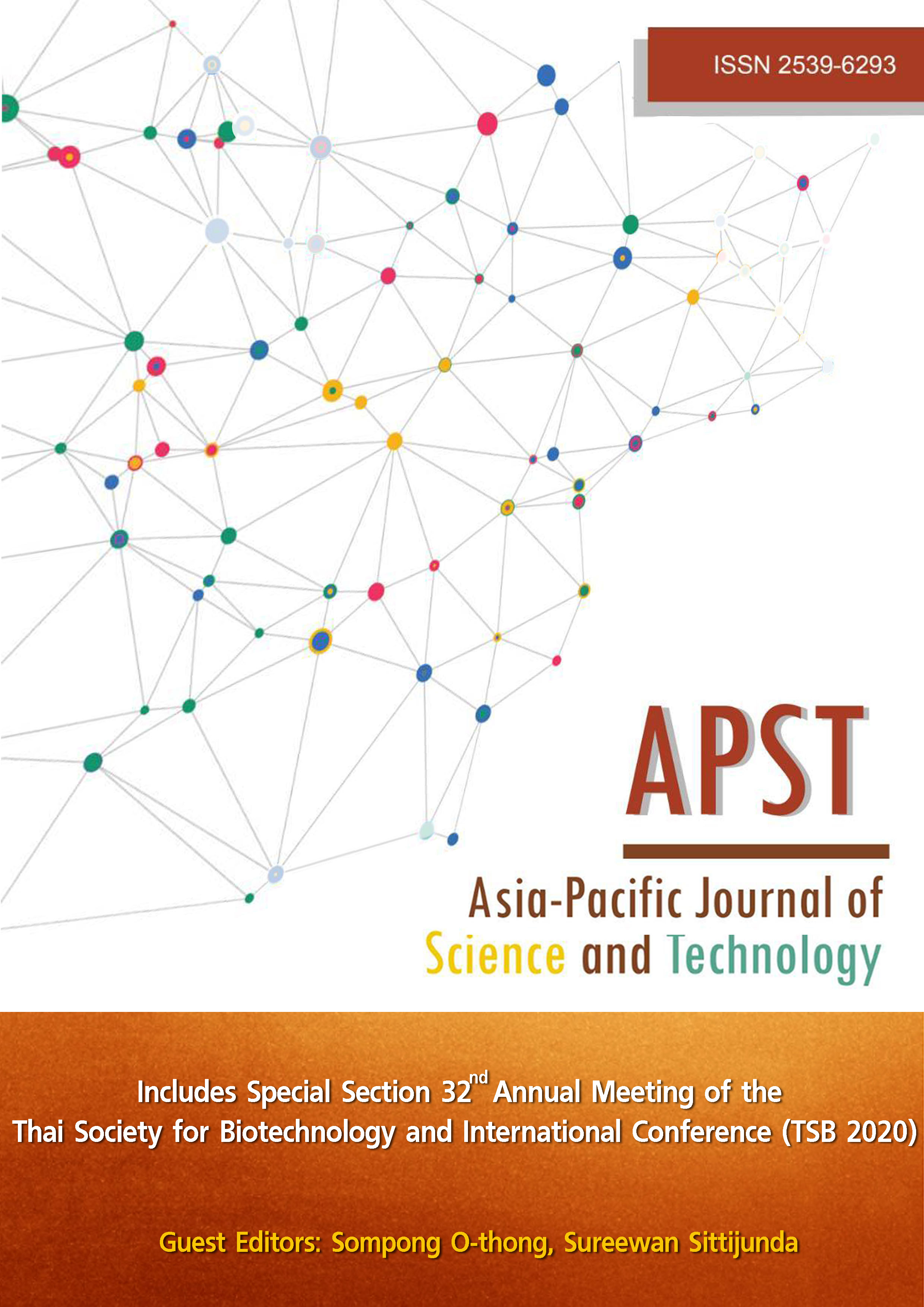Cytotoxic assessment of Cn-AMP1 in 2D or 3D spheroid non-small cell lung cancer models
Main Article Content
Abstract
Three-dimensional (3D) cellular spheroids have advantages for use in drug screening because they recapitulate cell-cell interactions relevant to important aspects of tumor biology. Non-small cell lung cancer is the most common form of lung cancer. Here, A549 cells were used for 3D spheroid establishment. The number of cells and culturing time were optimized to achieve optimal, reproducible spheroid formation. Use of 1 x 103 cells/well elicited the highest cell viability at day 5. In the presence of non-gelling concentrations of extracellular matrix, cell viability was slightly improved compared to extracellular matrix (ECM) - deprived conditions. Immunofluorescent staining revealed proliferative cells at the rim of the spheroids (Calcein-AM stained), whereas necrotic cells gradually increased over time at the core of the spheroid in both conditions. For drug assessment, cationic coconut antimicrobial peptide (Cn-AMP1) which was previously reported to be a promising peptide against colorectal cancer, was used. As anticipated, Cn-AMP1 decreased the cell viability of A549 in a dose-dependent manner in the Two-dimensional (2D) cell culture model. However, in parallel experiments in 3D, A549 spheroids, Cn-AMP1, did not demonstrate any cytotoxic effect. The 3D spheroid model might be feasible for use as a preclinical model for cytotoxicity assessment leading to a reduction in the use of animals in research.
Article Details
References
[2] Costa EC, Moreira AF, de Melo-Diogo D, Gaspar VM, Carvalho MP, Correia IJ. 3D tumor spheroids: an overview on the tools and techniques used for their analysis. Biotechnol Adv. 2016;34(8):1427-1441.
[3] Cui X, Hartanto Y, Zhang H. Advances in multicellular spheroids formation. J R Soc Interface. 2017;14(127).
[4] Edmondson R, Broglie JJ, Adcock AF, Yang L. Three-dimensional cell culture systems and their applications in drug discovery and cell-based biosensors. Assay Drug Dev Technol. 2014;12(4):207-218.
[5] Mandal SM, Dey S, Mandal M, Sarkar S, Maria-Neto S, Franco OL. Identification and structural insights of three novel antimicrobial peptides isolated from green coconut water. Peptides. 2009;30(4):633-637.
[6] Silva ON, Porto WF, Migliolo L, Mandal SM, Gomes DG, Holanda HH, et al. Cn-AMP1: a new promiscuous peptide with potential for microbial infections treatment. Biopolymers. 2012;98(4):322-331.
[7] Nath S, Devi GR. Three-dimensional culture systems in cancer research: Focus on tumor spheroid model. Pharmacol Ther. 2016;163:94-108.
[8] Jaukovic A, Abadjieva D, Trivanovic D, Stoyanova E, Kostadinova M, Pashova S, et al. Specificity of 3D MSC Spheroids Microenvironment: Impact on MSC Behavior and Properties. Stem Cell Rev Rep. 2020;16(5):853-875.
[9] Wong MK, Wahed M, Shawky SA, Dvorkin-Gheva A, Raha S. Transcriptomic and functional analyses of 3D placental extravillous trophoblast spheroids. Sci Rep. 2019;9(1):12607.
[10] Kochanek SJ, Close DA, Johnston PA. High Content screening characterization of head and neck squamous cell carcinoma multicellular tumor spheroid cultures generated in 384-well ultra-low attachment plates to screen for better cancer drug leads. Assay Drug Dev Technol. 2019;17(1):17-36.
[11] Liu J, Abate W, Xu J, Corry D, Kaul B, Jackson SK. Three-dimensional spheroid cultures of A549 and HepG2 cells exhibit different lipopolysaccharide (LPS) receptor expression and LPS-induced cytokine response compared with monolayer cultures. Innate Immun. 2011;17(3):245-255.
[12] Akizuki R, Maruhashi R, Eguchi H, Kitabatake K, Tsukimoto M, Furuta T, et al. Decrease in paracellular permeability and chemosensitivity to doxorubicin by claudin-1 in spheroid culture models of human lung adenocarcinoma A549 cells. Biochim Biophys Acta Mol Cell Res. 2018;1865(5):769-780.
[13] Maruhashi R, Akizuki R, Sato T, Matsunaga T, Endo S, Yamaguchi M, et al. Elevation of sensitivity to anticancer agents of human lung adenocarcinoma A549 cells by knockdown of claudin-2 expression in monolayer and spheroid culture models. Biochim Biophys Acta Mol Cell Res. 2018;1865(3):470-479.
[14] Gamerith G, Rainer J, Huber JM, Hackl H, Trajanoski Z, Koeck S, et al. 3D-cultivation of NSCLC cell lines induce gene expression alterations of key cancer-associated pathways and mimic in-vivo conditions. Oncotarget. 2017;8(68):112647-112661.
[15] Eguchi H, Akizuki R, Maruhashi R, Tsukimoto M, Furuta T, Matsunaga T, et al. Increase in resistance to anticancer drugs involves occludin in spheroid culture model of lung adenocarcinoma A549 cells. Sci Rep. 2018;8(1):15157.
[16] Stafford JH, Thorpe PE. Increased exposure of phosphatidylethanolamine on the surface of tumor vascular endothelium. Neoplasia. 2011;13(4):299-308.
[17] Marqus S, Pirogova E, Piva TJ. Evaluation of the use of therapeutic peptides for cancer treatment. J Biomed Sci. 2017;24(1):21.
[18] Liu S, Aweya JJ, Zheng L, Zheng Z, Huang H, Wang F, et al. LvHemB1, a novel cationic antimicrobial peptide derived from the hemocyanin of Litopenaeus vannamei, induces cancer cell death by targeting mitochondrial voltage-dependent anion channel 1. Cell Biol Toxicol. 2021.
[19] Meenach SA, Tsoras AN, McGarry RC, Mansour HM, Hilt JZ, Anderson KW. Development of three-dimensional lung multicellular spheroids in air- and liquid-interface culture for the evaluation of anticancer therapeutics. Int J Oncol. 2016;48(4):1701-1709.


